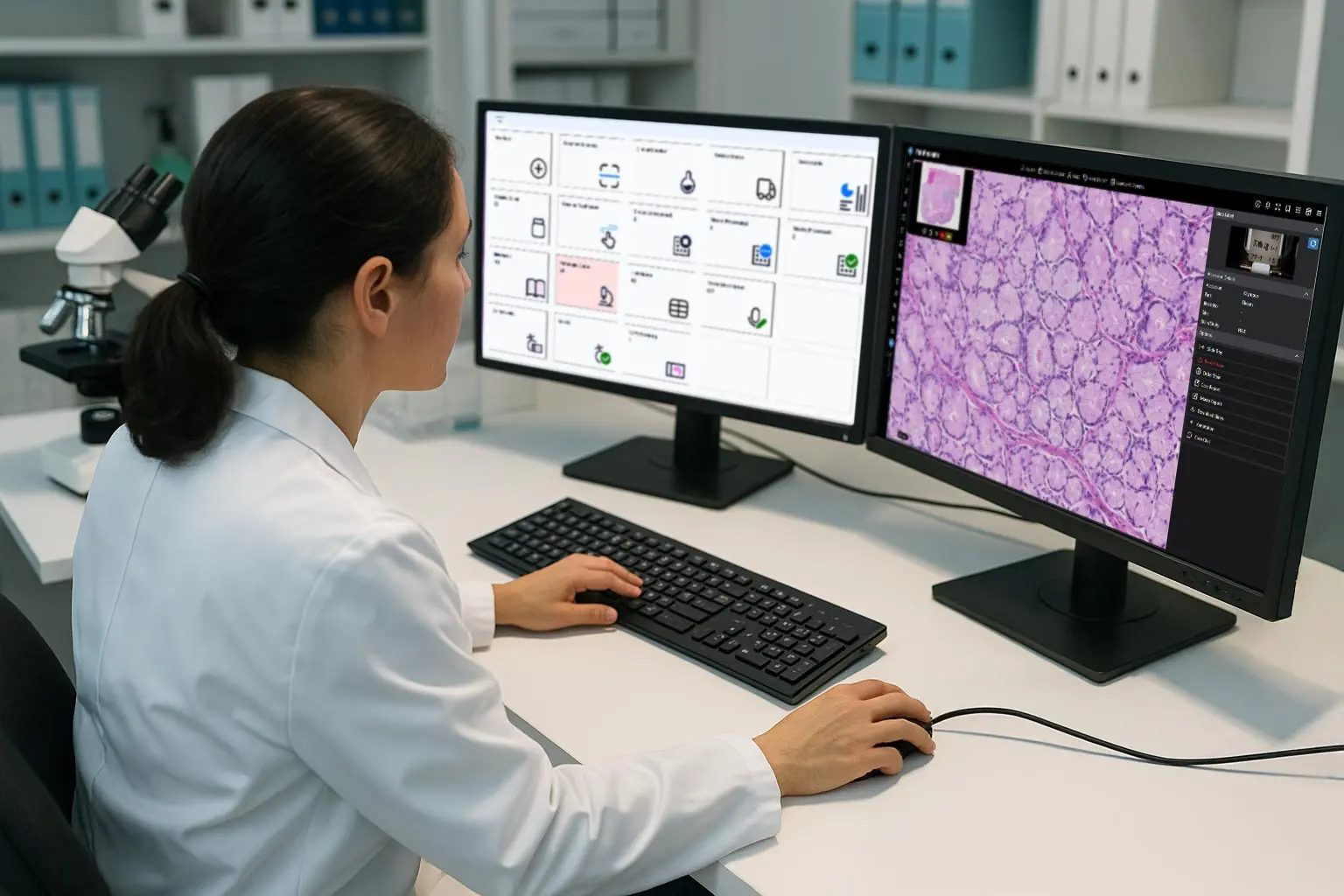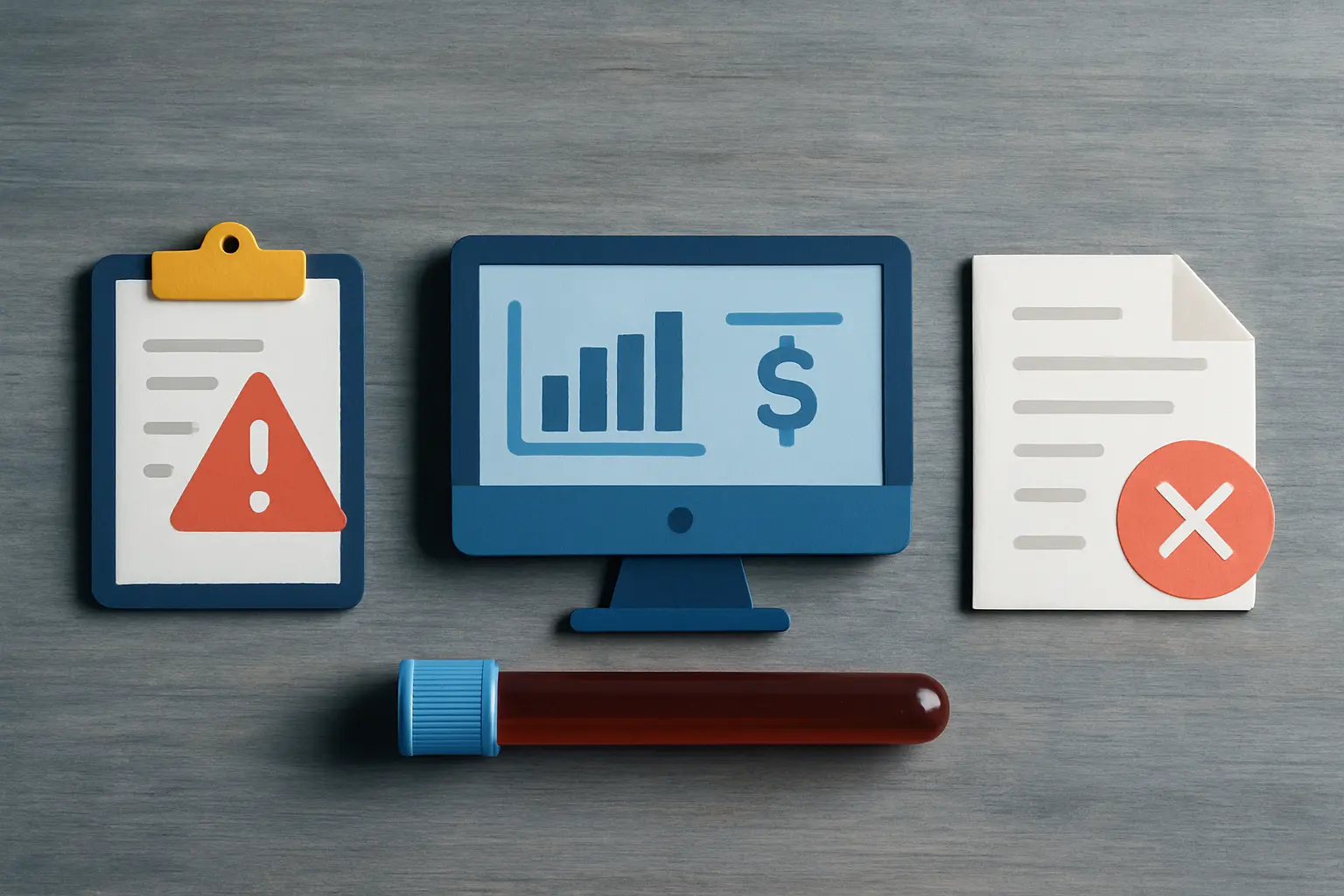Blog
Laboratory Information Management System Software: Advances in Clinical Lab Workflow
December 5, 2025
Laboratory workflow management in healthcare systems has expanded rapidly from relatively straightforward patient sample tracking processes with a pathology specimen tracking system to advanced pathology lab software solutions that support and automate laboratory data tracking, sample analysis, instrument integration, centralized data access, and storage.
It’s generally understood that a laboratory information system (LIS system) provides the backbone for laboratory administrative, operational, and financial pathology lab management workflows in medical labs.
For those unaware of the latest advancements and what’s possible with a modern LIS system, we invite you to continue reading our detailed breakdown of advanced pathology LIS software and its benefits.
Discover More: Can Your Laboratory Information System Support the Latest LIS System Technology?

LIS Systems - What Are They?
LIS system software, by definition, is designed to handle data management for a medical laboratory. The LIS system helps minimize the stress of managing a lab by improving the efficiency of collecting, tracking, and analyzing test results in a clinical setting. The full scope of the best laboratory information system software extends beyond effectively managing sample tracking processes to include various other important lab workflows, such as:
- Automated barcoding of samples
- Avoidance of manual error and test-code mismatches
- Monitoring of data analytics and lab audits
- Maintenance of lab equipment/instruments
- Management of workload among lab personnel and inventory
- Integration of the LIS system and laboratory billing software for easier and more accurate lab revenue cycle management (lab RCM)
Discover More: How to Turn Your Mid-Sized Medical Laboratory into a Thriving Large-Scale Operation
The LIS System and Clinical Laboratory Management
In healthcare, the LIS system integrates all processes that track a patient’s journey from test order to test result. From the moment a patient first encounters a hospital/clinic where an electronic health record (EHR) of the patient’s details are created, to when the final test report is generated, to when lab billing is completed, the LIS system interfaces with other laboratory software systems and analytical instruments to seamlessly exchange data, manage samples, automate workflows, and produce timely and accurate test results.
Hospitals and clinics handle large data streams and need the best laboratory information system software solutions to streamline and organize the data, thus enabling clinicians to draw clinical insights from a patient’s lab reports.
In addition to processing samples and performing required tests, a modern LIS system also supports critical functions such as regulatory compliance, documentation, resource management, and secure centralized data storage and access, all working together to enable efficient, end-to-end pathology lab management.
Discover More: The Four Most Important Things to Consider When Modernizing a Laboratory
.webp)
The Best Laboratory Information System Software Benefits
The best laboratory information system software stands out in its ability to digitize and automate clinical lab processes, enabling efficient pathology lab management. An advanced LIS system enhances workflow efficiency, accuracy, and connectivity, transforming laboratory operations for optimal performance.
The advantages that come with advanced LIS software include:
- Swift registration and barcoding of samples
- Flexibility in LIS lab solutions to adopt new tests/updates into a sample lab workflow
- Assurance of compliance with government regulatory bodies, to ensure the lab’s tests/diagnostics and quality control are up-to-date
- Standardized test workflows to ensure accuracy
- Integrates with instruments in the lab to maintain a unified interface for deploying a diagnosis/workflow
- The LIS system supports robust data management and seamless interoperability across multiple laboratory and clinical software systems, ensuring full integration between the lab and its customers
- Maintains a searchable audit trail
- Assured quality control of sample management
Discover More: Pathology Lab Management Guide - Best Laboratory Information System Software and Practices
Laboratory Information System Functions: How Do They Work?
A traditional LIS system manages patient samples and types of data associated with them (such as demographics, medical history, diagnostic tests run, results, lab billing, etc.).
Clinical laboratory workflows can quickly become complex due to the volume and interconnected nature of data generated across samples. A modern laboratory information system simplifies this complexity by tracking each barcoded specimen from the moment it arrives, loading it into the proper workflow, monitoring its progress at every stage, and automatically generating reports based on completed tests and recorded results. Consolidated patient data can then be easily searched and retrieved by authorized lab personnel through the LIS system’s centralized database.
A standard LIS lab workflow typically includes accessioning, documentation, sample tracking, results verification, reporting, and long-term sample management. Compared to manual record-keeping, LIS software platforms greatly reduce inconsistencies by enforcing standardized processes and leveraging barcode-driven identification. This leads to more accurate specimen handling, faster turnaround times, and improved patient safety.
The most advanced LIS system solutions also interface directly with laboratory instruments, enabling real-time status updates tied to each sample’s barcode and secure long-term data storage within an internal server or centralized database.
Case Study: Summit Pathology - Achieving Laboratory Profitability Amidst Operational Pressures

The Differences Between Laboratory Information Systems and Lab LIMS
It should be noted that laboratory information systems and laboratory information management systems (LIMS) are often used interchangeably, even though each application is designed for different lab environments.
The LIS system supports patient-centric lab workflow in a medical capacity. The lab LIMS refers to a sample-centric lab workflow that, in most cases, is not related to healthcare.
The top LIMS solutions, therefore, have broad applicability and can be deployed to support efficient sample handling across industrial, food and agricultural, and biomedical laboratory environments.
The best LIS software solutions prioritize patient data security and confidentiality, strictly adhering to regulatory standards like HIPAA to ensure compliance and privacy. Beyond data protection, the LIS system shares many core functions with lab LIMS solutions, including sample management and tracking, maintaining historical records, interfacing with laboratory instruments and software for seamless data exchange, and integrating lab analysis results into comprehensive reports.
Despite these similarities, LIMS system vendors build software that centers around samples (individually or in large batches) and must comply with standards or regulations that ensure good lab practices, such as ISO/IEC 17025.
As the best LIMS and best LIS software evolve, their functionalities will continue to overlap (LIS vs. LIMS). Because of this, laboratory information system vendors such as LigoLab must continue to make sure the differences are clear.
When selecting a laboratory information system, connect with LIS software vendors that can provide in-depth demonstrations of their pathology software and offer expert guidance on customizing the solution to meet the specific needs of a given laboratory.
Discover More: Automation in Pathology Lab Management Using Advanced LIS System Software
The Importance of the LIS System
In conclusion, the LIS system supports efficient integration of a lab’s workflows, and the best laboratory information system companies, with laboratory input, can modify and customize them to each lab’s unique requirements. For example, an anatomic pathology LIS system must facilitate a very different workflow than a molecular LIS.
Both minimize manual errors and improve lab productivity by recording and managing samples and patient data that would otherwise require interaction from lab personnel, thus improving the overall efficiency of a laboratory’s technical operations.
The Strategic Advantage of Choosing the Right LIS System Partner
Selecting the right LIS system - and the right vendor behind it - gives your laboratory a powerful competitive edge. A modern, flexible LIS system enables you to differentiate your services, strengthen client retention, attract new business, and quickly pivot as new opportunities emerge. This adaptability is essential for both immediate performance and long-term success.
Ready to equip your lab with an LIS system platform that supports growth, agility, and lasting competitive advantage?
Contact LigoLab to speak with a product specialist today.
Act Now: Speak with a Product Specialist!






